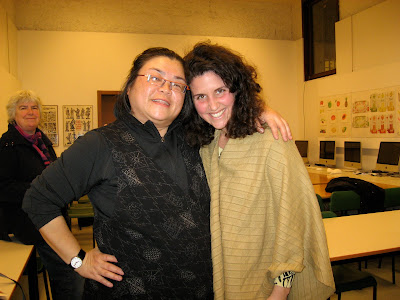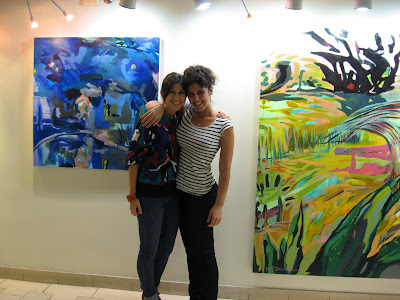
Tuesday, February 16, 2010
Thursday, October 22, 2009
 Ciao Cari!
Ciao Cari!Ho il piacere di invitarvi all'inaugurazione della mostra
giovedi questo, 22 ottobre
Club Ponte Storto
San Polo 1278, Venezia
seguira una cena, richiesta la prenotazione: clubpontestorto@hotmail.it
Spero di vedervi li!
Kaitlin
........
Hi Everyone!
By Boat
this Thursday, October 22nd
6pm
Club Ponte Storto
San Polo 1278, Venezia
following the reception will be a dinner, please reserve at: clubpontestorto@hotmail.it
Hope to see you soon!
Kaitlin
...
Alexandra la Conquistadora
Thursday, October 1, 2009

Hi Everyone!
Please join me for the opening reception of Pastorals at Berkeley University Gallery on Wednesday, October 7th, 5:30- 7:30 PM.
I hope you are well and to see you there!
Kaitlin
Pastorals
Berkeley University Gallery
3 East 43rd Street
New York, NY, 10017
(Between Madison and Fifth Avenue)
October 5 - October 30, 2009
Opening Reception:
Wednesday, October 7, 5:30-7:30 PM
www.kaitlinmcdonough.com
Wednesday, September 9, 2009
Sunday, September 6, 2009
Kaitlin McDonough: Wickedly, Wonderfully Alive
by Christopher Atamian
"To tell a story is an act of love. The teller reaches deep inside the listener's mind and offers rest and order where there would otherwise be none. The fairy tale does not deny the chaos of the universe. Rather, it offers the possibility that in a less than perfect world, it might still be possible to do something that's good."
--Chris Kraus, Aliens and Anorexia
Somewhere around mid-century, with the surrealist revolution now a thing of the past and pop and op art and their many derivatives coming to the fore, representational painting lost much of its authority; it stopped being the jewel in the artistic crown, the standard by which a person’s talent as a visual artist was judged. In the late nineteen seventies and eighties, technology (video art) and other developments (performance art, body, outsider art) accelerated (representational) painting’s downfall and contributed to putting at least a temporary nail in the coffin of painterly expertise. Slowly, painting has been making a comeback and luckily there are still some practitioners of the art who not only paint but do so with elegant sophistication and mastery: Ellen Harvey, Elizabeth Peyton, and John Currin all come to mind.
Kaitlin McDonough is another young painter of enormous talent. Trained at Boston University, the twenty-five year-old New Jersey native divides her time between Venice and New York. She paints large, life-sized oils which depict a wide range of allegorical and realist topics reminiscent of schools as diverse as German Expressionism, Japanese watercolor painting and Armenian realism. If she continues to paint with as much force and conviction, she should become an important contemporary artist.
The people who populate McDonough’s large wickedly alive paintings have for the most part all bitten from the edenic apple, figuratively or literally. In Apple Boat, (2007, 60” by 96”, oil on canvas) possibly her strongest painting to date, a naked woman lies on a row boat seemingly happily lost at sea, surrounded by three muscular men. One feeds her a soothing drink through a straw while another pulls apples from her womb and a third seems to be pleasuring her. Not surprisingly McDonough’s latter-day Eve wears a smile of contentment on her face—and who could blame her? The brushstrokes are powerful and geometric, recalling Beckmann and German Expressionism, but also a more recent American painter of note, Eric Fischl. The palette, a combination of muted yellows, blues, greens and reds, is a curious but completely successful choice for a latter day orgy-at-sea. Inevitably, the painting also refers back to Gericault’s 1819 Raft of the Medusa, particularly in the triangular composition and the choppy seas in the background, even if thematically they bear little in common. Though McDonough claims that any mythological references in her paintings are secondary to the story being told, Apple Boat and other works reveal an obvious debt to Western mythologies and religious symbolism: “I never explicitly set out to make any theological references,” McDonough told me recently…”but they are so obviously present in the work, even if they do not have overt religious meanings.” One of McDonough’s more remarkable talents is to portray happy but foreboding scenes: we’re not sure why, but behind this edenic setting, we fear the waves or the wind or perhaps even a shark attack. Something somehow seems to be ever so inscrutably amiss…
Three Rafts, another large 2007 oil painting complements Apple Boat. In this work, seagulls with bags of what McDonough terms “miracle food” in their beaks fly overhead. Again we find the same strong brush strokes and color palette but the three human figures seem to be in an indeterminate state: are they sunbathing (there is no sun)? Are they safe holding hands and relaxing or in danger? Lost at sea? Sated or starving? Here the seagulls who usually steal food seem to be bringing them sustenance instead. An interesting painting to juxtapose to the latter two is Knees in Barca which McDonough painted a year before: this night scene appears to take place on the Mediterranean but we see no actual people; just two sets of knees and the prow of a small boat. The gentler waves and light pastel color scheme imply a safer world, as if a couple had peacefully fallen asleep after a picnic at sea.
McDonough’s debt to Max Beckmann is most evident in a markedly different painting titled Dining Room Table. Here we are privy to a celebration of Armenian food laid out on a large round table, with a small group of people standing to the side. McDonough claims to not be able to prepare all these delicacies; hence, painting them becomes her equivalent as the artist substitutes easel and paintbrush for whisk and mixer. But the painting also brings up visceral memories for McDonough: “In Salman Rushdie’s Midnight’s Children, the mother cooks jealousy into the food. My grandmother did the opposite, she cooked love into hers.” The figures to the left of the table are painted with bold, geometric strokes with a certain graphic style that is emblematic of Beckmann and some of his German Expressionist colleagues. This flirtation with German expressionism and primitivism à la Gauguin is again evident in a few paintings that resemble woodcuts though they are in fact large oils as well, such as Alberoni, Palm, and Anchor Boat.
In two more large expressionistic works, “Splinter Angel” and “Haircut Angel” tall beautiful anthropomorphic angel-beasts respectively pull a splinter from someone’s foot and give another person a haircut. McDonough’s chiaroscuro, influenced as she acknowledges by Caravaggio, is indeed intense and takes on the quality of an animated drawing: it gives the works an almost Philip Guston-like quality. And while the concept may seem sophomoric at first, how can one not be charmed by a painting titled “Haircut Angel?” In it and its twin piece, McDonough illustrates the Hindu concept of Bodhisattva—the idea that a person is divine during moments of helping others. The piece naturally brings to mind the story of Samson and Delilah. Sex and sexuality, cutting as an act of castration and liberation: in the ambiguity of gesture, this haircut recalls the apples that in a previous painting are pulled from the womb. Both “Splinter Angel” and “Haircut Angel” capture moments where a person or angel comes to the aid of another and may well be the truest illustrations of what McDonough terms “accessing holy moments.”
A series of watercolors and oils loosely termed “In the Woods” are variations on a theme. One particular image of two people having a conversation on a bridge departs significantly from her other works described here in technique as well as content and thematics. They experiment in both media (oil and watercolor) and color: Conversation Yellow and Purple versus Conversation Blue and White for example—the same image, people whose features we cannot make out, keeping both their own identities and the identity of their conversation hidden (A happenstance meeting? Idle gossip? Lovers quarreling?). These paintings somehow recall both Chinese landscapes and Japanese watercolors, something oriental in the brushstroke as well as in the selection and repetition of the same visual topos.
Another serendipitous example of McDonough’s work, the hilarious Gram on a Camel (2006, 60” by 48”) which captures both a certain heroism (the seriousness in her grandmother’s face, itself camel-like) and the utterly unlikely scenario of anyone’s grandmother riding a camel like a jockey at a racetrack! Here and in some other of McDonough’s oils, consciously or unconsciously, one finds a strong link to the noted Armenian realist Martiros Sarian (see his 1911 painting Date Palm, for example) both in terms of palette, style and themes—Sarian also delighted in painting camels.
McDonough cites Peter Doig as an influence. To me McDonough’s canvases seem more alive with actual and implied action, though a certain debt to Doig is discernible in some of McDonough’s use of color and choice of subject matter, particularly in his lovely 1998 Canoe-Lake. McDonough is also an extremely well-read painter who admits that her debt to writers is as great as to other artists, citing for example Milan Kundera and his theories of lightness and heaviness of being. McDonough’s painting has recently taken on a more relaxed quality and grown more abstract. She is before all else a storyteller, a raconteur and re-interpreter of myths, a painter of encounters between man and fellow human, man and beast, man and nature. McDonough sees these different stories, from her grandparents’ exile during the Assyrian Genocide or Seyfo and the Armenian Genocide or Medz Yeghern, to the Biblical parable of Adam and Eve as extensions of a basic human condition: “I think everyone feels like they are fallen in a sense of missing something, as if they are searching for home. To me, it’s a basic quality of human existence,” she explains: “Of course with Armenians, it seems more explicit because we were recently physically expelled from our homes in a very real, tangible way.” If we are all exiled or fallen then, one would like to ask this wise young painter where we are headed and what forms the journey will take. For an answer, one might want to keep an eye on McDonough’s next paintings. As an afterthought, McDonough refers back to her painting The Dining Room Table: “My grandmother was a superb cook. I can’t access these Armenian delicacies by cooking them the way she could. But I can paint them into being. Painting allows me to navigate the gap between reality and my biggest dreams.”
You can view more of McDonough’s work at kaitlinmcdonough.com
Mes Arménies












